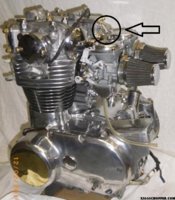When Yamaha started building these bikes they new a lot about crankcase pressures and vacuums. Two strokes won't run if these things are not right.
On the early years they had two nipples with hoses run down below and behind the engine. They were vents so the crank case would not over pressure and blow out the seal. As time went by they made changes to this breather system. They plugged one side and just ran one hose. They ran this hose through a hole in the left side engine cover so excess oil blowby would lube the chain.
They added a restrictor in the side with one hose to help slow down excess oil blowby. Along in there somewhen they dropped the oil capacity from 3000 cc's to 2500cc's. This also helped with excess oil blowby.
I don't think the hooked hoses into the carbs till around 80, when they went to the BS34 carbs. They also changed from a two nipple brearther to a single nipple breather, this smaller housing with one nipple was when they started plumbing the breather into the carbs. The nipple had a small hole to act as a restrictor.
Plumbing it this way did two things, it prevented excess oil blow by getting out and added a small vacuum to the crank case. This vacuum help slow weeping gaskets and seals. It also helps the rings seal better.
You might want to look up inside the nipples you have. I think by 78 they had one side plugged and the restrictor installed in the other side.
I have one of the later sungle nipple breathers on my 75 with a short piece of the stock hose, about two inches, run to a power brake check valve. The inlet side of the check valve is a perfect fit in the stock hose. Other do the same with the out let side pointing to one of there pod air filters. I run a 3/8's size hose off the outlet down to behind and below the engine. Some do thuis with a filter in the end of the hose. I think the filter is a wate. The lenght of hose, especially after it gets a coat of oil is plenty of filter. Any air coming out of the long hose won't be drawn back in the engine because of the one way valve.
Even with out the valve any air drawn back in won't reach the engine. The length of hose and the built in restriction won't allow it. The oily hose collects most of any dirt that might be drawn in.
Leo



